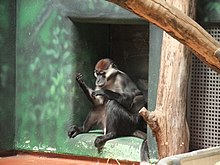The collared mangabey (Cercocebus torquatus), also called red-capped mangabey and white-collared mangabey,[3] is a species of primate in the family Cercopithecidae of Old World monkeys. It formerly included the sooty mangabey as a subspecies. As presently defined, the collared mangabey is monotypic.[1]
| Collared mangabey[1] | |
|---|---|

| |
| Scientific classification | |
| Domain: | Eukaryota |
| Kingdom: | Animalia |
| Phylum: | Chordata |
| Class: | Mammalia |
| Order: | Primates |
| Suborder: | Haplorhini |
| Infraorder: | Simiiformes |
| Family: | Cercopithecidae |
| Genus: | Cercocebus |
| Species: | C. torquatus
|
| Binomial name | |
| Cercocebus torquatus (Kerr, 1792)
| |

| |
| Geographic range | |
Description
editThe collared mangabey has grey fur covering its body, but its common names refer to the colours on its head and neck.[4] Its prominent chestnut-red cap gives it the name red-capped, and its white collar gives it the names collared and white-collared.[4] Its ears are black and it has striking white eyelids, which is why some refer to it as the "four-eyed monkey".[4] It has a dark grey tail that exceeds the length of the body and is often held with the white tip over its head.[4] It has long molars and very large incisors.[5] The average body mass for captive individuals ranges from 9 to 10 kg (20 to 22 lb) for males and 7.5 to 8.6 kg (17 to 19 lb) for females.[5] Head-body length is 47–67 cm (19–26 in) in males and 45–60 cm (18–24 in) in females.[4]
Distribution and habitat
editThe collared mangabey is found in coastal, swamp, mangrove, and valley forests, from western Nigeria, east and south into Cameroon, and throughout Equatorial Guinea, and Gabon, and on the Gabon-Congo border by the Atlantic shore.[2]
Behavior and ecology
editThe collared mangabey lives in large groups of 10 to 35 individuals including several males.[6] Vocal communication in the form of cackles and barks are used to keep the group in contact and signal their position to other groups. It has a diet of fruits and seeds, but also eats leaves, foliage, flowers, invertebrates, mushrooms, dung, and gum.[5][6] The collared mangabey has no defined breeding season, it reaches sexual maturity at five to seven years, and has an average gestation period of 170 days.[6]
Threats
editIn 2006, it was estimated that annually about 3,000 collared mangabeys are hunted in the Cross-Sanaga-Bioko coastal forests for the bushmeat trade.[7]
Conservation
editThe collared mangabey is listed as endangered on the IUCN Red List due to habitat loss and hunting for bushmeat.[2] It is also listed on Appendix II of CITES and on Class B of the African Convention on the Conservation of Nature and Natural Resources.[2]
References
edit- ^ a b Groves, C. P. (2005). Wilson, D. E.; Reeder, D. M. (eds.). Mammal Species of the World: A Taxonomic and Geographic Reference (3rd ed.). Baltimore: Johns Hopkins University Press. p. 154. ISBN 0-801-88221-4. OCLC 62265494.
- ^ a b c d Maisels, F.; Oates, J.F.; Linder, J.; Ikemeh, R.; Imong, I.; Etiendem, D. (2019). "Cercocebus torquatus". IUCN Red List of Threatened Species. 2019: e.T4201A154210757. doi:10.2305/IUCN.UK.2019-1.RLTS.T4201A154210757.en. Retrieved 16 November 2021.
- ^ Rowe, N. (1996). The Pictorial Guide to the Living Primates. Pogonia Press, Charlestown, Rhode Island. ISBN 0-9648825-0-7.
- ^ a b c d e Richardson, M. (2009). "Red-capped mangabey (Cercocebus torquatus)". ARKive. Archived from the original on 22 September 2015. Retrieved 6 January 2012.
- ^ a b c The Primata (2007). "White-collared Mangabey (Cercocebus torquatus)". The Primata. Archived from the original on 4 February 2013. Retrieved 6 January 2012.
{{cite web}}: CS1 maint: unfit URL (link) - ^ a b c Nguyen, K.H. (1999). "Cercocebus torquatus". Animal Diversity Web. Retrieved 6 January 2012.
- ^ Fa, J.E.; Seymour, S.; Dupain, J.E.F.; Amin, R.; Albrechtsen, L. & Macdonald, D. (2006). "Getting to grips with the magnitude of exploitation: bushmeat in the Cross–Sanaga rivers region, Nigeria and Cameroon". Biological Conservation. 129 (4): 497–510. Bibcode:2006BCons.129..497F. doi:10.1016/j.biocon.2005.11.031.
